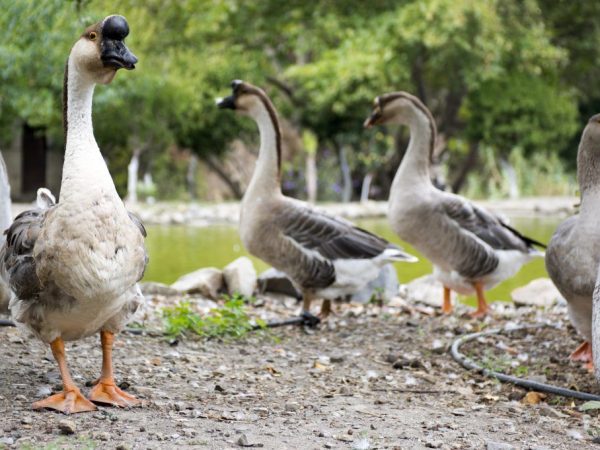Chinese breed of geese
Chinese geese became permanent residents of farms, being first domesticated in North China Manchuria, hence their name.

Chinese geese
Features of the Chinese breed
Chinese geese have been bred on European territory since the 18th century. The ancestors of the modern breed are considered dry-nosed - feathered representatives common in East Asia and southern Siberia.
Today, the breed of Chinese birds is divided into two branches: gray Chinese and white. Gray birds are often called brown birds. This plumage shade can be seen in the photo of Chinese geese.
The general description of the Chinese breed of geese includes their main features:
- the trunk is of medium size, slightly elongated in length with a slightly raised front part,
- a fairly elongated neck with a strong bend, reminiscent of a long swan,
- an elongated head with a bump on the forehead typical of the breed,
- rounded chest, gradually turning into a tightly folded belly,
- the beak is small, bright orange or dark brown, sometimes closer to black, depending on the breed type of the bird,
- short tail,
- tightly folded paws set to the side,
- dense plumage with high density.
The average weight of a goose is up to 4.5 kg, a slightly higher weight for geese is from 5 to 6 kg.
White Chinese
White geese from China emerged as a result of domestication of the wild goose (otherwise called the gnarled Chinese goose) in the process of crossing with gray and Indian goose representatives.
The white Chinese has been divorced in Russia for quite a long time, having begun its domestic history in the former USSR.
The appearance of the white Chinese goose fits the general description of the breed as a whole:
- swan neck,
- a prominent bump in the frontal part of the head.
The white goose differs from other representatives only in the color of the plumage. Its beak, frontal bump, metatarsus and paws are colored bright orange.
Farmers fell in love with the white breed for its unpretentious maintenance and care, noting very good hereditary reproduction rates, reaching 70-80%. Newborn goslings are highly resilient, up to 99%.
White birds from China gain body weight in the range of 4.0 to 5.5 kg, while nine-week-old goslings weigh about 3.0 kg. White geese begin to lay eggs from the age of 270 days. Usually goose-laying starts in December and lasts for 6 months. White Chinese geese lays up to 70 eggs with an average weight of 150 g each in one laying.
In white Chinese geese, farmers note that they are often aggressive in character.
Gray chinese
Chinese gray geese, like their white-plated relatives, originated from the wild gnarled representative in the 18th century, arriving in Europe from China. Within our country, the gray representative was ubiquitous.
Often, gray birds are used for crossing with other breeds of geese in order to improve the meat characteristics of poultry.
The gray Chinese goose is distinguished by its appearance.Its plumage is painted in a gray-brown shade, and the edges of the wings, shoulder and tibia are crowned with a milky-white border. The thoracic region is pale brown. Along the top of the neck to the shoulder region, starting from the head, there is a thin dark strip called a belt. The beak of the gray Chinese goose together and the frontal lump are colored black.
The gray Chinese geese lag slightly behind the white type in productivity. The oviposition of gray geese consists of 45-60 eggs weighing up to 120 g.
Conditions of detention and nutrition
Keeping unpretentious Chinese geese is easy. Among the conditions for their comfortable living there are:
- warm and dry room,
- lack of drafts in the place where birds live,
- the presence of an effective ventilation system,
- access of birds to natural feeding places during daylight hours,
- unlimited access to a feeding trough and drinking water.
When cold weather sets in, they try not to bring the Chinese breed of geese to fresh air, leaving them in a warm room to avoid frostbite of the birds.
The diet of the feathered Chinese should include:
- chopped root vegetables,
- cereal mixed with bone meal,
- mineral and vitamin complexes,
- mixtures of salt and chalk.
Winter feeding of the Chinese includes two meals a day, while feeding portions in the morning should preferably be smaller in volume than in the evening.
When breeding a breed originally from China, farmers need to remember that these birds do not tend to incubate the laid eggs, therefore incubators are often used to introduce offspring.


